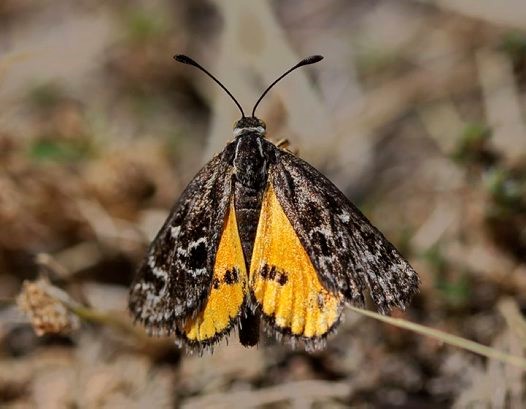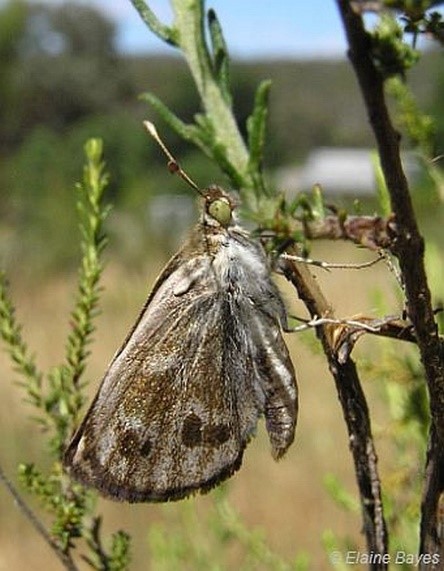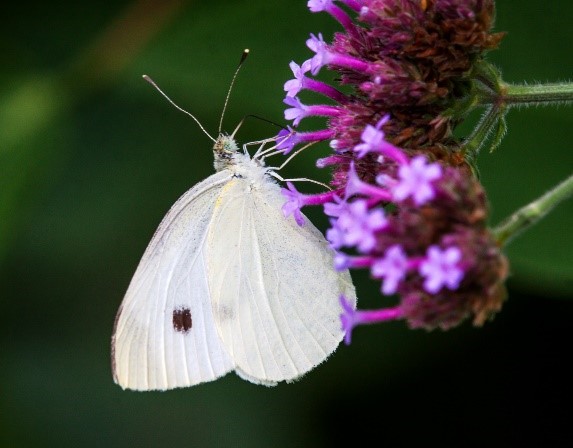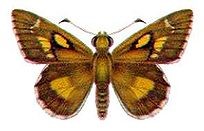The Sanctuary Lakes warm summer has brought an unusually high number of Butterflies and Moths flitting around our estate, gardens and homes. Butterflies and Moths look very similar and both belong to same insect family, the Lepidoptera, but there are obvious differences to look for, making it easier to tell them apart.
Firstly, the most well-known, butterflies usually rest with their wings closed, while the majority of moths' rest with their wings open, Skippers rest with their front wing held at a different angle to the back wing. Caterpillar moths create silky cocoons, while butterfly caterpillars usually make a shiny chrysalis. Skippers spin a pad of silk onto a stem or leaf then hang on the pad and form the pupae. If you can observe them up close, you will notice that butterflies have long, thin antenna, while moths have shorter feathery antennas. Finally, the simplest and most obvious, is that butterflies and skippers generally gather food during the day while moths are seen more at night time.
There are numerous species of butterflies and moths to be seen around the Sanctuary Lakes Estate so, I have selected three whose life patterns appear to be the most interesting this season. One, a native of the Victoria Volcanic Plains, the Golden Sun Moth. An immigrant, the White Cabbage Butterfly and finally a repeat look at our very own Altona Skipper Butterfly.
 Female Golden Sun Moth (Synemon plana) Once, the most plentiful moth on the Victorian Volcanic Plains, but due to its breeding reliance on the native Austrodanthonia family grasses, which were disseminated by European pastoralists, the Golden Sun Moth became critically endangered, almost to the point of extinction. Fortunately thanks to replanting of native grasses within Sanctuary Lakes, Skeleton Creek and the Point Cook Homestead, this warm summer has seen over a thousand sightings in our area. Another season of similar sightings will move it towards an endangered status.
Female Golden Sun Moth (Synemon plana) Once, the most plentiful moth on the Victorian Volcanic Plains, but due to its breeding reliance on the native Austrodanthonia family grasses, which were disseminated by European pastoralists, the Golden Sun Moth became critically endangered, almost to the point of extinction. Fortunately thanks to replanting of native grasses within Sanctuary Lakes, Skeleton Creek and the Point Cook Homestead, this warm summer has seen over a thousand sightings in our area. Another season of similar sightings will move it towards an endangered status.
The Golden Sun Moth is a slightly larger moth with a wing size of around 3.5cm. The females can be identified by their dark grey forewings with lighter grey patterning. The hind wings are a very distinctive bright orange with black spots along the edges. The male's forewings are dark brown with lighter grey patterning, hind wings bronze to brown with dark brown patches. Both males and females have clubbed antennae.
The female rarely flies, unless it is disturbed, and tends to walk between tussocks of grass to lay eggs. The male spends its entire life flying, searching for females to mate with. It flies during the hottest part of bright sunny days, from November to February.
 Male Golden Sun Moth The male flies in a zig-zag pattern about one metre above the ground. The female has a smaller hindwing and is a very poor flyer.
Male Golden Sun Moth The male flies in a zig-zag pattern about one metre above the ground. The female has a smaller hindwing and is a very poor flyer.
Breeding occurs between mid-November and February. Once the moths have mated, females spend their short adult life laying eggs within clumps of Grass. Females are estimated to lay from 100 to 150 eggs. The eggs hatch after about 21 days and the larvae (caterpillars) tunnel underground where they remain feeding on grass roots for as long as two years before digging a vertical tunnel to the surface where the pupa remains for six weeks when the adult moths emerge. When females emerge from the tunnel as adults, they already possess fully developed eggs and begin to search for a mate. Adult Golden Sun moths have no physical means of feeding and live for only one to four days.
Spring no sooner peeks around December than the White Cabbage Butterflies are on the wing, searching out nectarine from dandelions and daisies, looking for broccoli and cabbage to start laying their eggs. They are the most abundant butterfly in Sanctuary Lakes and they will fly right into your garden. The Whites have a really long season, December to March and they have qualities as interesting as more exotic insects. They were accidentally introduced into Australia being first recorded in Melbourne in 1929.
 White Cabbage Butterfly (Pieris Rapae) The sex of White Cabbage Butterflies can be readily determined. In addition to the dark spot at the outer "corner" of the forewing, upper (dorsal) side, females have two dark spots mid-wing, one above the other; males have only one. They spend their winter as pupae and emerge in early spring. After mating they lay their eggs on large green leafed plants, particularly relishing cabbage and broccoli. Eggs are usually laid on the underside of the leaf, where the caterpillars also hang out. Caterpillars are a beautifully camouflaged velvety green with faint white lines along the sides. They chew big holes in the leaves. If you see this kind of damage, turn the leaf over and look carefully: you can probably apprehend the culprit.Caterpillars will eat for 17 days, before becoming pupae for eight days, finally emerging as white butterflies. There may be several generations each year.
White Cabbage Butterfly (Pieris Rapae) The sex of White Cabbage Butterflies can be readily determined. In addition to the dark spot at the outer "corner" of the forewing, upper (dorsal) side, females have two dark spots mid-wing, one above the other; males have only one. They spend their winter as pupae and emerge in early spring. After mating they lay their eggs on large green leafed plants, particularly relishing cabbage and broccoli. Eggs are usually laid on the underside of the leaf, where the caterpillars also hang out. Caterpillars are a beautifully camouflaged velvety green with faint white lines along the sides. They chew big holes in the leaves. If you see this kind of damage, turn the leaf over and look carefully: you can probably apprehend the culprit.Caterpillars will eat for 17 days, before becoming pupae for eight days, finally emerging as white butterflies. There may be several generations each year.
 Altona Skipper Butterfly (Hesperilla flavescens) Like the Golden Sun Moth, our own Altona Skipper was close to extinction, again due to agricultural changes and then housing development. Five years ago, Friends of Altona Coastal Park, Port Phillip and Westernport Catchment Management Authority, and Hobsons Bay City Council collaborated to create corridor extensions for the endangered Altona Skipper Butterfly, who breeds, feeds, lives and dies thanks, only to one species of plant, the tussock grass Chaffey Saw Sedge. It is integral to the Skipper's survival and suitable planting conditions were identified in the wetter areas of Altona’s coast. Over the years successful planting has occurred. In the established beds, vegetation now replicates the pre-European woodland that was once widely abundant in our area. The link between the current beds makes a wildlife corridor for the Skipper along the coastal fringes. Just north of Skeleton Creek is Truganina Park which successfully now has the largest stands of Chaffey Saw Edge in our district. Thanks to our northerly winds the Altona Skipper has been blown down from Truganina Park to Skeleton Creek and into Sanctuary Lakes own Chaffey Saw Edge plantings where they have started to establish themselves. This year's warm summer seems to have helped and numerous sighting around the Estate. Giving the good news that the Altona Skipper has risen from the near extinction to an endangered status.
Altona Skipper Butterfly (Hesperilla flavescens) Like the Golden Sun Moth, our own Altona Skipper was close to extinction, again due to agricultural changes and then housing development. Five years ago, Friends of Altona Coastal Park, Port Phillip and Westernport Catchment Management Authority, and Hobsons Bay City Council collaborated to create corridor extensions for the endangered Altona Skipper Butterfly, who breeds, feeds, lives and dies thanks, only to one species of plant, the tussock grass Chaffey Saw Sedge. It is integral to the Skipper's survival and suitable planting conditions were identified in the wetter areas of Altona’s coast. Over the years successful planting has occurred. In the established beds, vegetation now replicates the pre-European woodland that was once widely abundant in our area. The link between the current beds makes a wildlife corridor for the Skipper along the coastal fringes. Just north of Skeleton Creek is Truganina Park which successfully now has the largest stands of Chaffey Saw Edge in our district. Thanks to our northerly winds the Altona Skipper has been blown down from Truganina Park to Skeleton Creek and into Sanctuary Lakes own Chaffey Saw Edge plantings where they have started to establish themselves. This year's warm summer seems to have helped and numerous sighting around the Estate. Giving the good news that the Altona Skipper has risen from the near extinction to an endangered status.